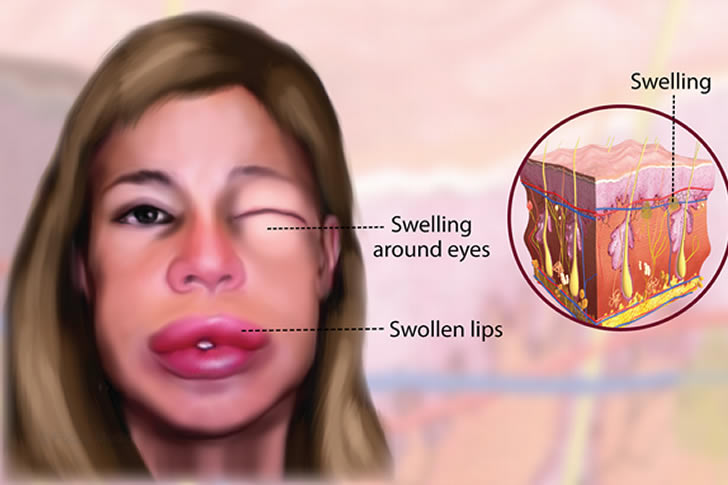Comprehensive Overview of Angioedema
Angioedema is a medical condition characterized by the rapid swelling of the deeper layers of the skin and mucosa, often occurring in response to an allergen, medication, or other triggers. This condition can be alarming and uncomfortable, potentially leading to life-threatening scenarios if the swelling obstructs airways. A comprehensive understanding of angioedema can aid in its management and treatment, ensuring better outcomes for those affected.

Understanding Angioedema: Types and Causes
Angioedema can be classified into several types, each linked to different causes. The most common types are hereditary angioedema (HAE), acquired angioedema (AAE), and allergic angioedema. HAE is a rare genetic disorder caused by the deficiency or dysfunction of the C1 inhibitor protein, with about 1 in 50,000 to 1 in 150,000 people affected worldwide. AAE, on the other hand, usually develops later in life and can be associated with autoimmune disorders or lymphoproliferative diseases. Allergic angioedema is perhaps the most familiar type, occurring as part of an allergic reaction to foods, medications, or other substances.
Triggers for angioedema are varied, ranging from specific medications like ACE inhibitors, which are reported to cause angioedema in 0.1% to 0.7% of patients, to common allergens such as nuts, shellfish, and bee stings. Stress, minor infections, or even certain physical stimuli like pressure, cold, or heat can also provoke episodes.
Symptoms and Diagnosis of Angioedema
The primary symptom of angioedema is sudden, intense swelling beneath the skin surface. While it can occur anywhere on the body, the most common sites include the eyelids, lips, genitals, hands, and feet. In more severe cases, swelling in the throat, tongue, or lungs can lead to difficulty breathing or swallowing, necessitating immediate medical attention.
Diagnosing angioedema involves a careful clinical evaluation of the symptoms, a detailed patient history, and, in some cases, specific blood tests or skin tests. For hereditary angioedema, blood tests to measure the levels and functionality of C1 inhibitor are crucial. Imaging tests may be required if abdominal attacks, which can cause severe pain, nausea, and vomiting, are suspected.
Treatment: Managing Symptoms and Preventing Attacks
Management of angioedema focuses on relieving symptoms, treating acute attacks, and preventing future episodes. Treatment depends on the type of angioedema diagnosed. For allergic angioedema, antihistamines and corticosteroids are commonly used to reduce inflammation and swelling. In cases of HAE or AAE, drugs that increase the levels of C1 inhibitor or bradykinin B2 receptor antagonists like icatibant are prescribed to prevent or reverse the episodes.
In emergency scenarios, particularly when airway obstruction is a concern, administration of epinephrine might be necessary. Long-term management might include avoidance of known triggers, and in the case of HAE, preventive medication such as C1 inhibitors, androgens, or other agents that help reduce the frequency and severity of attacks.
Living with Angioedema: Lifestyle Considerations and Coping Strategies
Living with angioedema requires adapting lifestyle choices and coping strategies to manage the condition effectively. Patients are advised to maintain a diary to note down potential triggers and reaction patterns. This practice can help in identifying specific substances or activities to avoid. Dietary changes may also be necessary, especially for those with allergy-induced angioedema, to exclude allergenic foods from their diet.
Emotional and psychological support is also crucial in coping with angioedema, as frequent and unpredictable attacks can lead to anxiety and stress. Support groups and counseling can provide necessary emotional support and practical tips for managing the condition.
Recent Advances and Research in Angioedema Treatment
Recent years have seen significant advances in the understanding and treatment of angioedema. New therapies, such as monoclonal antibodies that target specific pathways involved in swelling, are currently under research and have shown promise in clinical trials. For instance, lanadelumab, a monoclonal antibody that inhibits plasma kallikrein, has been approved for preventing HAE attacks, offering new hope for those living with this challenging condition.
Furthermore, ongoing research into the genetic and molecular mechanisms underlying angioedema not only provides insight into more tailored treatments but also assists in the development of novel diagnostic tests, making early detection and intervention possible.
Angioedema is a complex and often challenging condition, but with the right knowledge and resources, it can be effectively managed. Patients should engage with healthcare professionals who specialize in allergic and immunologic disorders to develop an appropriate treatment and management plan. Understanding the condition, recognizing symptoms early, and having an action plan in place are crucial steps in ensuring safety and improving quality of life for those affected by angioedema.







Recent Comments